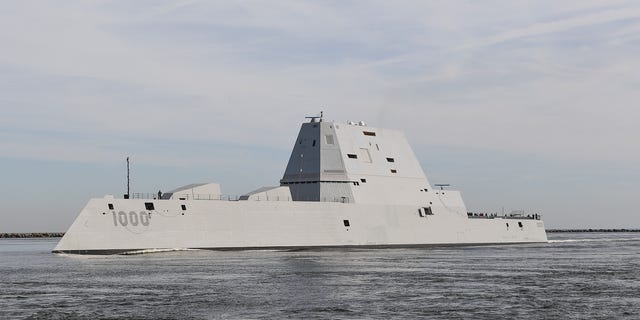The USS Zumwalt and her two sister ships are undergoing a dramatic change of mission just three years after the first ship was commissioned. The destroyers, originally meant to provide naval gunfire support for the Marines and bombard targets far inland, are now being reorientated to a ship-killer role.
The Zumwalt-class of destroyers was meant to dramatically boost the fleet’s gun firepower. After the retirement of the four Iowa-class battleships in the early 1990s, the service studied a number of solutions before deciding on the Zumwalts. Each ship would be equipped with two 155-millimeter Advanced Gun Systems, each firing a precision-guided Long Range Land Attack Projectile to ranges of up to 83 miles.
The U.S. Navy originally planned to buy 32 destroyers, a number that was cut to seven ships, and then finally to just three. The cost of the LRLAP projectile, originally pegged at $50,000 each, ballooned to $800,000 each making them unaffordable to even the mighty U.S. Navy. Without enough ships and guns, the Zumwalts were in danger of becoming the white elephants of the fleet.
The Zumwalt destroyer program has been an expensive mess. The program has cost $23 billion to date, producing just three ships with an average cost of $7.8 billion—more than three times the cost of Arleigh Burke-class guided missile destroyers that make up the bulk of the Navy’s surface fleet. Furthermore the ships are five years late and, without LRLAP ammunition, cannot fulfill their original mission.
Now, less than three years after lead ship Zumwalt joined the fleet, the service is changing the ships’ mission from land attack to surface warfare—sinking other ships. In addition to the two guns, each ship has eighty Mk. 57 vertical launch armored missile silos capable of carrying a mix of offensive and defensive weaponry.
The Zumwalts, according to Warrior Maven, will carry the latest version of the Tomahawk cruise missile, the Maritime Tomahawk missile. Maritime Tomahawk will allow the ship to strike other ships at sea, potentially hundreds of miles away using friendly assets such as high-altitude drones and P-8A Poseidon aircraft to provide target data.
Another weapon Navy officials envision putting on the Zumwalts is a laser weapon in the 150 kilowatt class. The Zumwalts are some of the first ships with an Integrated Power System that generates up to 78 megawatts—enough to power thousands of homes. The destroyers need a capacitor system to store and then quickly surge power to a laser.
Although not powerful enough to meaningfully damage larger ships, a 150 kilowatt laser could be used against small, swarming boats such as those favored by Iran’s Revolutionary Guards Corps, drones, and incoming missiles. Lasers can burn holes in ship hulls, torch flying drones and slice off control surfaces, and explode the propellant or warhead in an incoming missile.
Ultimately, according to Warrior Maven, the Navy will position the Zumwalts as “bridge” ships between the old Navy and a Navy equipped with lasers, railguns, and other energy intensive weapons. The Zumwalts will mix both chemical energy (gunpowder) and electrical energy weapons on the same platform. Within the next twenty or thirty years the service may not build ships with chemical energy weapons at all.
Meanwhile, the Navy is taking a wait and see approach to the two Advanced Gun Systems on each ship. The service is waiting for a “new bullet” that offers “the longest range possible for land attack strike and surface warfare”. This would likely be a rocket propelled, guided artillery shell capable of engaging moving enemy ships at very long ranges or fulfilling the ship’s original mission.
The three ships in the Zumwalt class are USS Elmo Zumwalt, former Chief of Naval Operations, USS Michael Monsoor, a Navy SEAL who posthumously won the Congressional Medal of Honor in Iraq, and USS Lyndon B. Johnson, 36th President of the United States.

Kyle Mizokami is a writer on defense and security issues and has been at Popular Mechanics since 2015. If it involves explosions or projectiles, he's generally in favor of it. Kyle’s articles have appeared at The Daily Beast, U.S. Naval Institute News, The Diplomat, Foreign Policy, Combat Aircraft Monthly, VICE News, and others. He lives in San Francisco.















